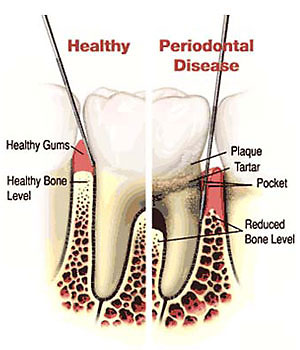Periodontal Disease is a bacterial infection around the supporting structures of teeth. If left untreated, it causes supporting bone to be lost from around the teeth. Periodontal disease is the number-one cause of tooth loss in the United States today. There are three stages to periodontal disease: gingivitis, periodontitis, and advanced periodontitis.
Plaque, a sticky film of food and bacteria, forms constantly on teeth. If it isn't removed daily, it begins to harden and forms tartar (calculus). In this early stage, before bone loss has occurred, the gums become red and swollen; this is gingivitis. There are many factors that can contribute to gingivitis, including smoking, stress, inadequate nutrition, diabetes and other systemic diseases, as well as hormonal changes such as puberty and pregnancy. Fortunately, gingivitis is reversible with professional treatment and good oral hygiene.
As the plaque and tartar work their way down below the gum line, the gums begin to separate away from the teeth, forming pockets. Once a pocket has formed, the process accelerates, as new, even more destructive types of bacteria begin to populate the pocket. If the tartar isn't removed by dental professionals, your body's defensive reaction to the infection produces enzymes that cause the loss of supporting bone; this is periodontitis. Often, this destructive process has very mild or no symptoms, until it progresses into the advanced stages.
Over time, if periodontitis continues unchecked, this bone loss continues. Eventually, so much bone is lost that some of the teeth begin to become loose. This is advanced periodontitis




